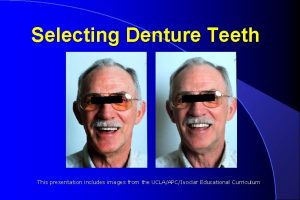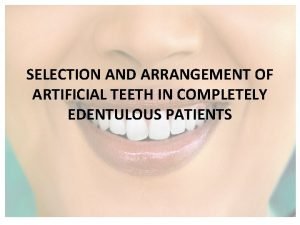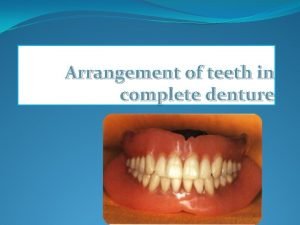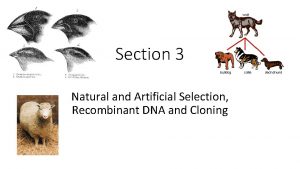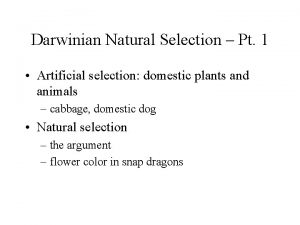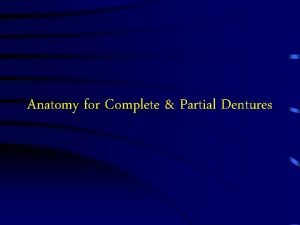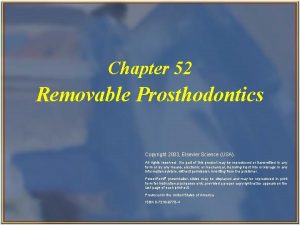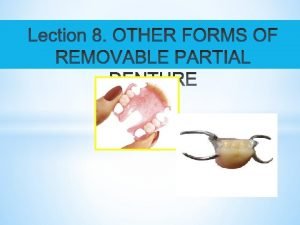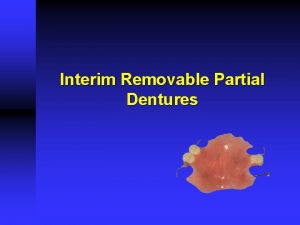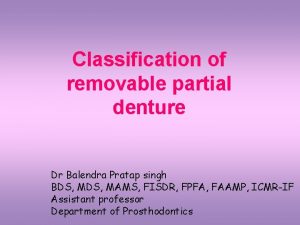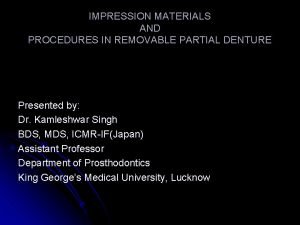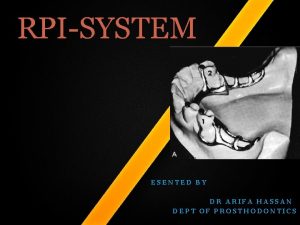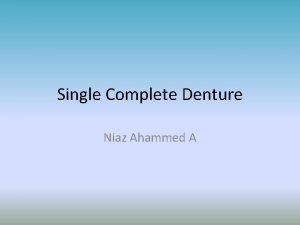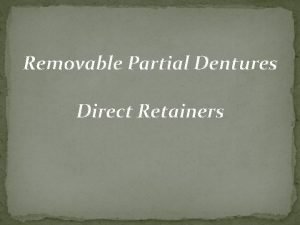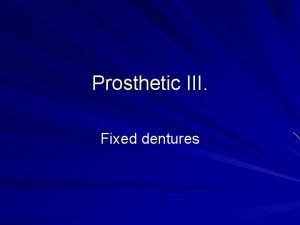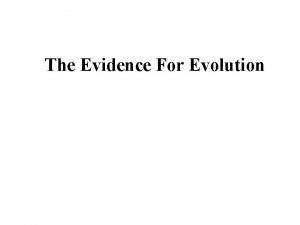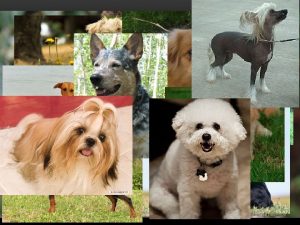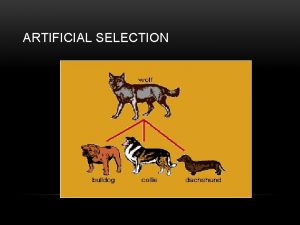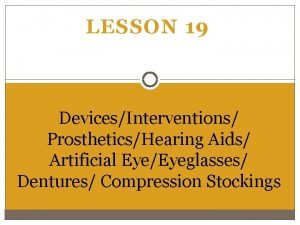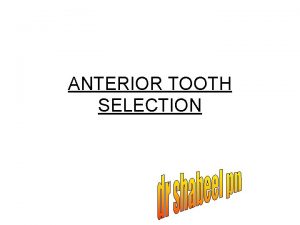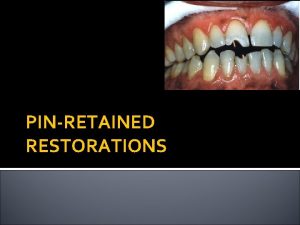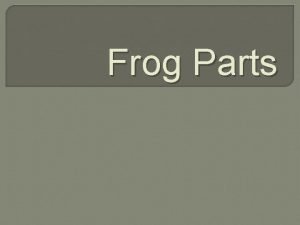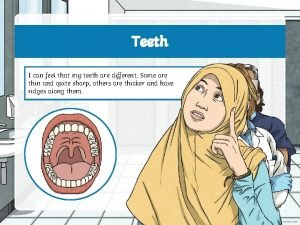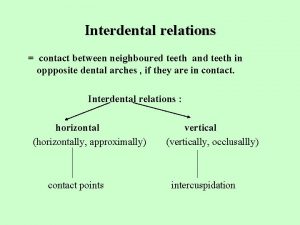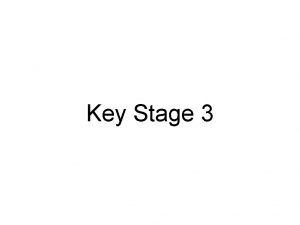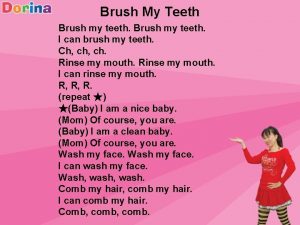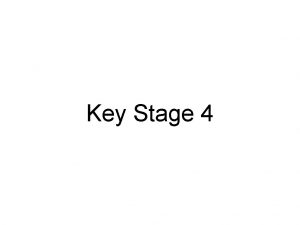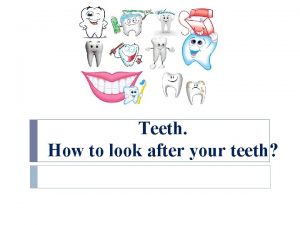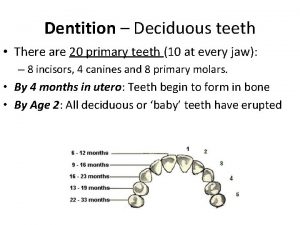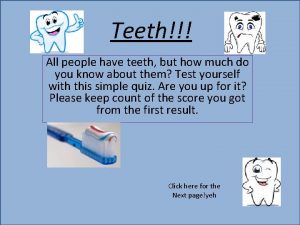Selection of Artificial Teeth For Dentures 1 Dr



























- Slides: 27

Selection of Artificial Teeth For Dentures 1 Dr. Sabreen Waleed Aswad

2 Introduction Teeth selection is very important as the selection of the appropriate shade, size, and form of the artificial teeth determines the esthetic and function of the denture.

3 Objectives of teeth selection 1 - Maintain the vertical dimension. 2 - To restore esthetic. 3 - To restore function (speech and mastication )

Selection Of Artificial Teeth Include 4 Selection of anterior teeth. Selection of posterior teeth.

5 Records Of Shade, Size, And Form Of Teeth Could Be Obtained From Pre. Extraction Records Which Include 1. Preserved Extracted Teeth 2. Previous Diagnostic Casts With Natural Teeth. 3. Pre-extraction Radiograph. 4. Pre-extraction Photograph. 5. Observation of teeth of close relatives. 6. the old denture might help in teeth selection by ask the patient, it (like or dislike) the teeth then and decide change or not.

Factors to be considered when pre-extraction records are not available 6 1. shade 2. size 3. form 1. Shade selection Factors affect shade selection 1. Age 2. Gender 3. Complexion 4. patient preference

7 2 -Size To select the size of anterior teeth, we have to consider the following: I. The length of anterior teeth Which is controlled by: a-length of upper lip b- lower lip c- inter ridge space

II- Width of anterior teeth a) 8 The width from the tip of left canine to the tip of right canine is almost equal to the width of the nose (interalar width)+7 mm

9 b) The width of maxillary central incisor equals approximately to 1/16 of bizygomatic width.

c)10 Width of the anterior teeth can be measured on maxillary occlusal rim depending on the intraoral anatomical landmarks like: (buccal frenum, corner of the mouth, and canine eminence).

11 3 - Form The form or outline of anterior teeth depend on the following : 1 - facial form According to frontal view: The face could be classified into: square, ovoid , and tapering. The maxillary central incisor form should be in harmony with patient face.

12

2 - Gender 13

3 - Age 14

4 - personality 15 It seems reasonable that a large vigorous type of persons have teeth of more square, large teeth with prominent markings, different from those of delicate appearing persons.

5 -16 Patient Preference

17 Selection of posterior teeth Factors considered in selection of posterior teeth : 1 - shade 2 - form 3 - size

18 1 - shade Ø Shade of posterior teeth should be harmonized to the shade on anterior teeth, Ø maxillary first premolars are sometimes used for esthetic more than function, so it is advisable to select premolar teeth with lighter color than the other posterior teeth, but not lighter than anterior teeth. Ø Generally the shades of posterior teeth are slightly darker than anterior teeth.

19 2 - size • Occlusogingival height It is determined by the available interarch distance. The occlusal plane should be located at the midpoint of the interocclusal distance.

20 • Buccolingual Width Ø The buccolingual width of posterior teeth should be slightly narrower than natural teeth, Ø Broader teeth encroach into the tongue space leading to instability of the denture. Also, the teeth should not encroach into the buccal corridor space to avoid cheek biting.

21 • Mesiodistal length Ø The combined mesiodistal lengths of all maxillary posterior teeth in that side of the arch should be equal to the distance between canine line, and anterior border of maxillary tuberosity. For mandibular posterior teeth, the mesiodistal lengths should be equal to distance between the canine line and anterior border of retromolar pad. Ø. The teeth should not be placed over displaceable tissues like the retromolar pad as it will cause tipping of the denture during function.

22 3 - occlusal form q. Anatomic teeth. Simulate the natural teeth form with inclination approximately 33 degree

23 Advantages: 1 - More efficient in chewing. 2 - They can be arranged in balanced occlusion in eccentric position. 3 - More acceptable esthetically. 4 - More compatible with surrounding oral environment.

24 q Non anatomical teeth: Flat and without cusp height.

25 Advantages: 1 - Offer less resistance in non-masticatory movement like (bruxism); therefore less damaging to the supporting structure. 2 - More comfortable. 3 - Offer less resistance to lateral forces therefore, they are indicated in excessively resorbed ridges.

Materials of artificial teeth 26 No. There are two main types, acrylic and porcelain teeth. Acrylic teeth Porcelain teeth 1. They are made from acrylic resin. We have vacuum fired and air fired, the vacuum fired is better because they are harder and have luster 2. They are not brittle, but poor abrasion resistance, so they might become worn down with consequent loss of vertical dimension They are brittle and thus susceptible to fracture, more resistance to abrasion. 3. Esthetic very good, but cannot maintain luster for long time. Excellent esthetic, does not stained, and maintain luster for long time. 4. Chemical bonding with denture base Mechanical bonding by pins or undercut holes 5. 6. Easily ground and polished. There is no clicking during contact. Difficult to grind and polish There is clicking during contact

27 Thank you
 Squint test is used as a guide for selecting teeth
Squint test is used as a guide for selecting teeth Posterior teeth
Posterior teeth Natural selection vs artificial selection
Natural selection vs artificial selection Difference between continuous and discontinuous variation
Difference between continuous and discontinuous variation Disruptive selection.
Disruptive selection. Similarities
Similarities Natural selection vs artificial selection
Natural selection vs artificial selection Tooth setting complete denture
Tooth setting complete denture Transgenic organisms examples
Transgenic organisms examples Artificial selection
Artificial selection Artificial selection
Artificial selection Darwin's epic journey
Darwin's epic journey Artificial selection
Artificial selection Why is artificial selection used
Why is artificial selection used Figure 19
Figure 19 What is an example of artificial selection
What is an example of artificial selection Natural selection 3
Natural selection 3 Maxillary tuberosity
Maxillary tuberosity Elsevier
Elsevier Swing lock labial bar
Swing lock labial bar Bracing in rpd
Bracing in rpd Larell dentures
Larell dentures Intracoronal direct retainers
Intracoronal direct retainers Partial denture classification
Partial denture classification Best impression material for partial dentures
Best impression material for partial dentures Rpi and rpa system
Rpi and rpa system Vertical
Vertical Requirements of direct retainers
Requirements of direct retainers
